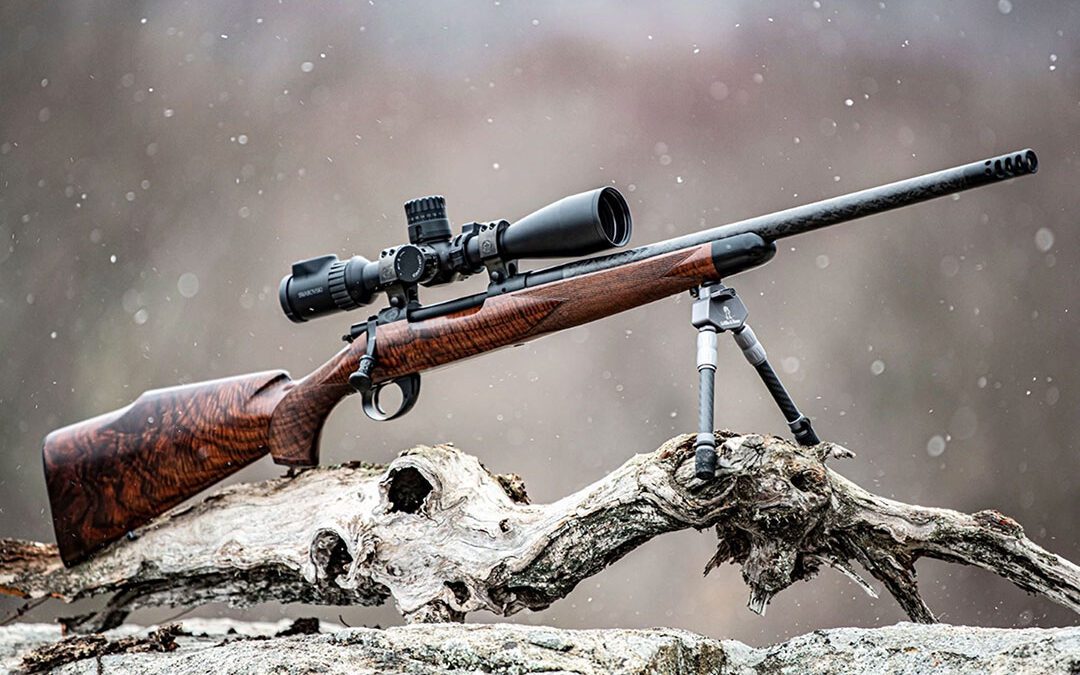It can be argued that a rich and storied history may well be a company’s most valuable asset. No matter how great the legacy, though, like any inheritance, it can easily be squandered.
Some outfits, for example, simply sit back on their haunches hoping that the glow from their long past “golden era” continues to sustain the image of their current offerings. It’s a strategy typically heavy on sepia-toned images, but little else. Others have resorted to a sleight of hand, a marketer’s bag of tricks where “new” and “improved” are just a different shade of makeup on the same old face. Ask any U.S. auto executive about the damage done to certain iconic brands through “badge engineering,” the practice by carmakers to use a few cursory styling changes to, for example, “transform” a Chevy into a Cadillac.
Then, there are those companies committed to making the most of their long-held and often hard-won reputations. The American riflemaker, Griffin & Howe (G&H), sits squarely in that camp. Its recent lightweight, yet highly accurate mountain rifle, the Highlander, is a case in point. Now, with its new All American rifle the company decided to really go for the fences, to step up to the plate fully intending to hit one out of the ballpark.
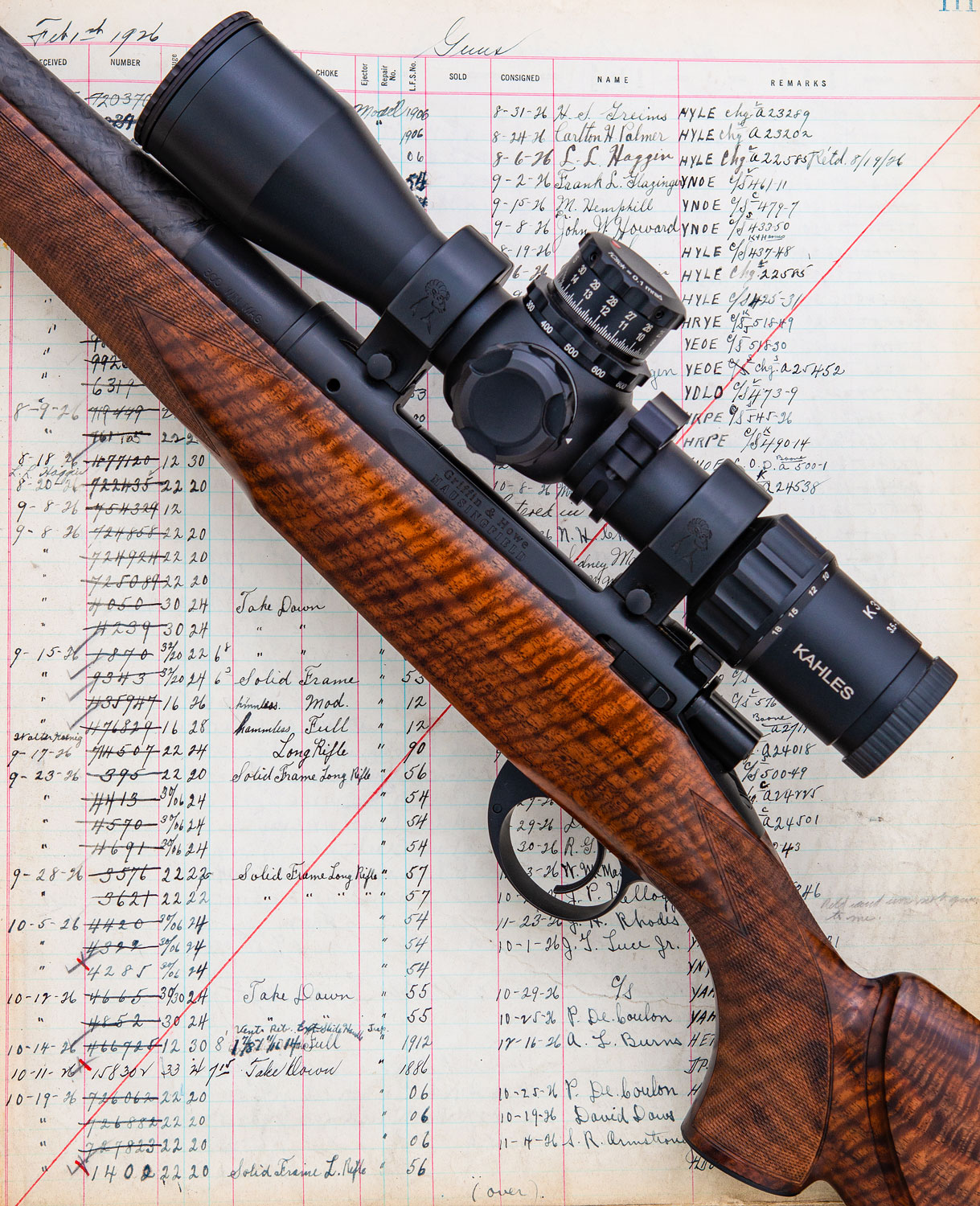
The first inning of this game, if you will, started more than 100 years ago when the Springfield Armory in Massachusetts, then our country’s primary facility for small arms development and production, unveiled the Army’s new service rifle officially designated as “United States Magazine Rifle, Model of 1903, Caliber .30,” but popularly known as the ’03 Springfield. The impetus for this rifle came during the Spanish American War of 1898 when the Krag-Jorgensen rifles carried by U.S. troops fell quite short in performance to the German-designed Mauser rifles with which the Spanish forces were equipped.
Not surprisingly, the Army’s new service rifle was heavily influenced by the German Mauser action, which had quickly established itself as the gold standard for bolt-action rifles. None other than President Theodore Roosevelt got the ball rolling when he praised the Springfield rifle for its effectiveness in hunting game in his classic book, African Game Trails. Roosevelt did lament the fact, however, that it was difficult to obtain a Springfield with a proper sporting stock.
Intrigued by the President’s book, a fellow sportsman and, by trade, a cabinetmaker in New York City, Seymour Griffin, decided to try his hand at sporterizing a Springfield. In 1910, he purchased a Springfield barreled action and a blank of high-grade French walnut and set to work.
Thirteen years later, Griffin teamed up with gunsmith and accomplished metal worker James V. Howe and the firm of Griffin & Howe was launched, operating out of a loft on East 39th Street in New York City. While Howe soon left, his name remained in the company title and, by the mid 1920s, G&H was producing high-grade bolt action rifles mostly built on Springfield actions, each an exemplar of Old-World craftsmanship, elegant lines and subtle, but beautifully executed, engraving.
A major change occurred in 1930 when Griffin & Howe was purchased by Abercrombie & Fitch, America’s then-preeminent sporting goods store located in the heart of Manhattan at the corner of Madison Avenue and East 45th Street. Known for its extraordinary customer service, Abercrombie & Fitch was also dedicated to helping customers better enjoy their outdoor passions. The store, for example, featured a shooting range in its basement and a casting pool located on the roof.
Helping to run Abercrombie & Fitch’s firearms operation, which occupied the entire seventh floor, G&H broadened its experience, especially in the areas of gunsmithing, gun fitting and working individually with customers, whether on shooting instruction or plans for an African safari. Over the years, these activities became a key aspect of Griffin & Howe’s DNA.
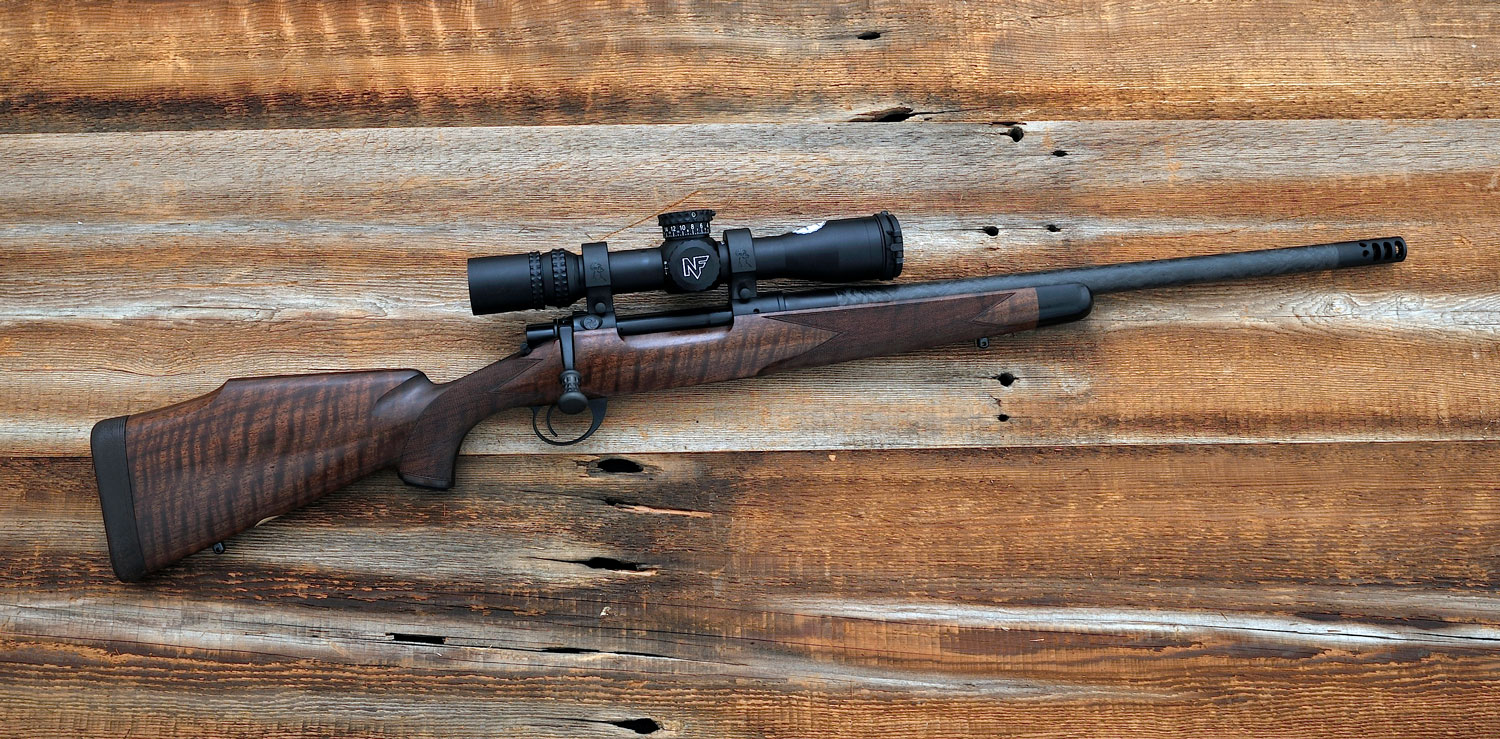
Abercrombie & Fitch shuttered its New York City store in 1977 and Griffin & Howe once again set off on its own. In recent years, under its current ownership, G&H has invested heavily not only in re-establishing its high grade rifle credentials but also in building on its reputation in respect to customer service and also providing customers with expert instruction whether with rifle or shotgun. What’s more, the company has stayed close to its roots, and is now headquartered not an hour or so from New York City at Hudson Farm, a 4,000-acre facility in northern New Jersey that includes its retail, gunsmithing and gunmaking operations as well as an array of shooting facilities in all disciplines.
Very much a blend of the old with the new, the All American model makes full use of the latest accuracy enhancing technology together with the company’s signature “piece,” its distinctively featured and finely handcrafted walnut stock. “We’ve had,” notes G&H gunsmith and gun maker, Andrew Cote, “almost 100 years to define and to refine what makes a quality stock shape in terms of comfort and usability for a hunting rifle.”
In true bespoke fashion, each All American rifle is a one-of-a-kind firearm hand-built to a customer’s measurements and personal specifications. “Every one of these rifles is a full build from start to finish,” points out Joel Pelanka of G&H’s marketing department, “so the first step for the customer is to come to our facility to get measured for the stock.”
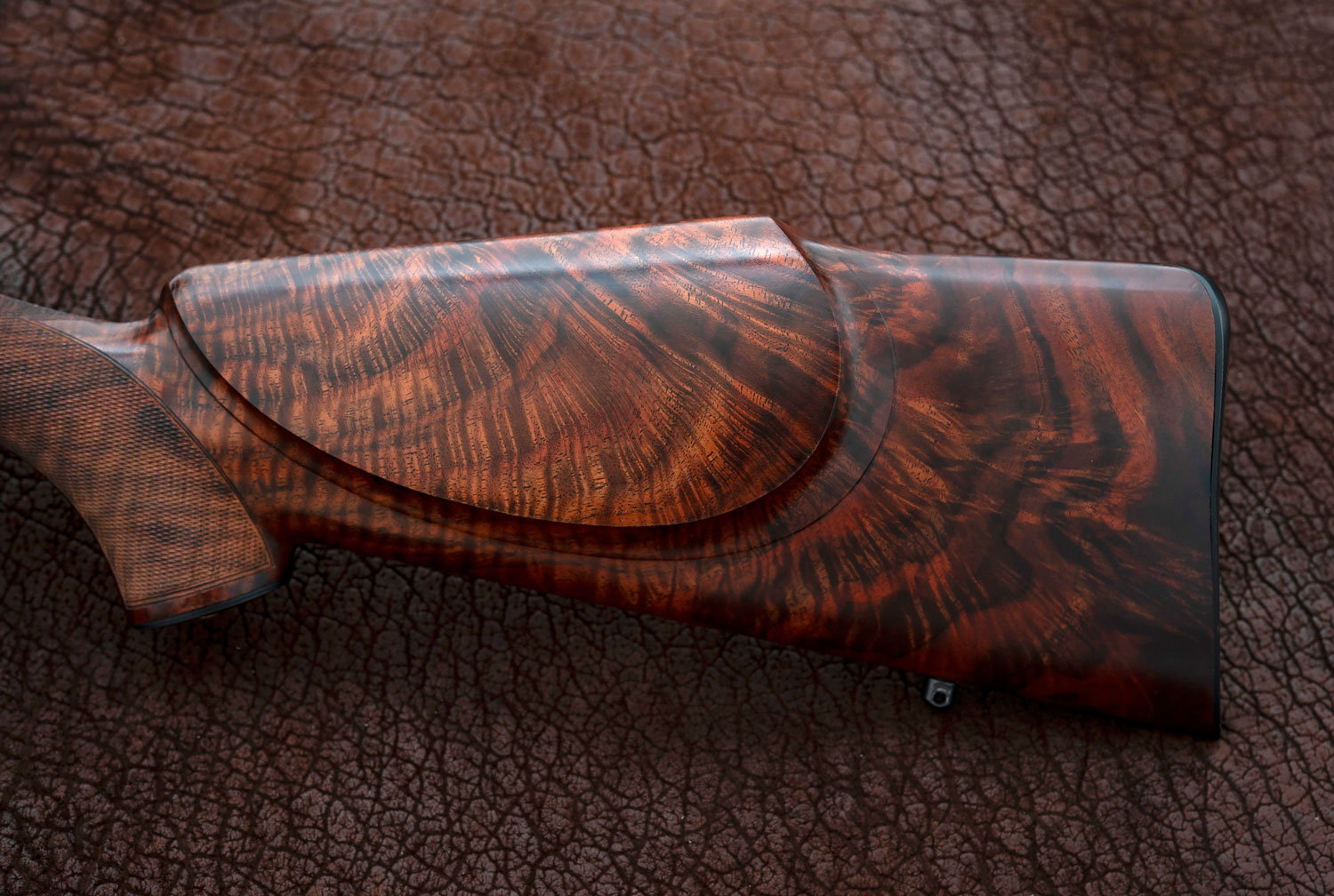
While typically associated with high-grade shotguns, G&H believes a made-to-measure stock on a rifle is also of value in that it allows the shooter, when the rifle is mounted, to instantly have the barrel lined up perfectly with the shooter’s natural line of sight. “When the stock is really tuned into you,” adds Andrew Cote, “you do not have to think about the mount, you just think the shot and all you’re looking at is the animal and you know you’re spot on.”
With measurements in hand, the customer has the opportunity to select the wood for the rifle from G&H’s selection of exhibition grade American black walnut blanks. This is a species of walnut that is harder and stronger than European walnut and G&H has put together an impressive selection of blanks both in terms of lighter to darker shades, all with 80 to 90 percent figure on both sides. Cote makes the point that, “This wood has been growing for 100, 150, perhaps 200 years and now you have it in front of you as a varnished slab for you to see the nature of that individual tree’s growth. It’s really something special.” So is the standard leather covered recoil pad, a G&H tradition.
“There are, of course,” notes G&H CEO Steve Polanish, “a number of ways we can customize and personalize the rifle to each customer. For my rifle, for example, I chose to go with a skeleton butt stock and skeleton grip cap with inlaid initials.”
At the “new” end, but with a traditional legacy, the All American rifle uses a Mausingfield action from the aptly named American Rifle Company. It is well described by the manufacturer as, “A unique fusion of modern design and battle-proven features from bolt actions past.” A match grade action with controlled-round feeding, the Mausingfield features a Mauser-style non-rotating claw extractor with a Springfield style inertial ejection.
“What that translates into,” explains Cote, “is that each round is controlled from the moment that it has begun its trip to being fed into the barrel. If you end up having some sort of jam, some sort of issue, with that round being held on to from the moment you start pushing the bolt forward, all you have to do is pull the bolt back and throw the round up. The hard-fixed ejector adds a measure of reliability. You are not dealing with a spring and a plunger but with one fixed object that is mechanically lifted into place to kick that round out.”
Machined from high quality steels, Mausingfield actions are both strong and tough with an exceptionally smooth and slick bolt throw. The bolt head is coated with a diamond-like carbon that further reduces friction between moving parts and adds an extremely hard and weather resistant layer on the exterior surfaces. G&H uses a titanium floor plate for weight savings and added rigidity. Speaking of titanium, the rings supplied with each rifle are also made of this lightweight but exceptionally strong and rigid metal.
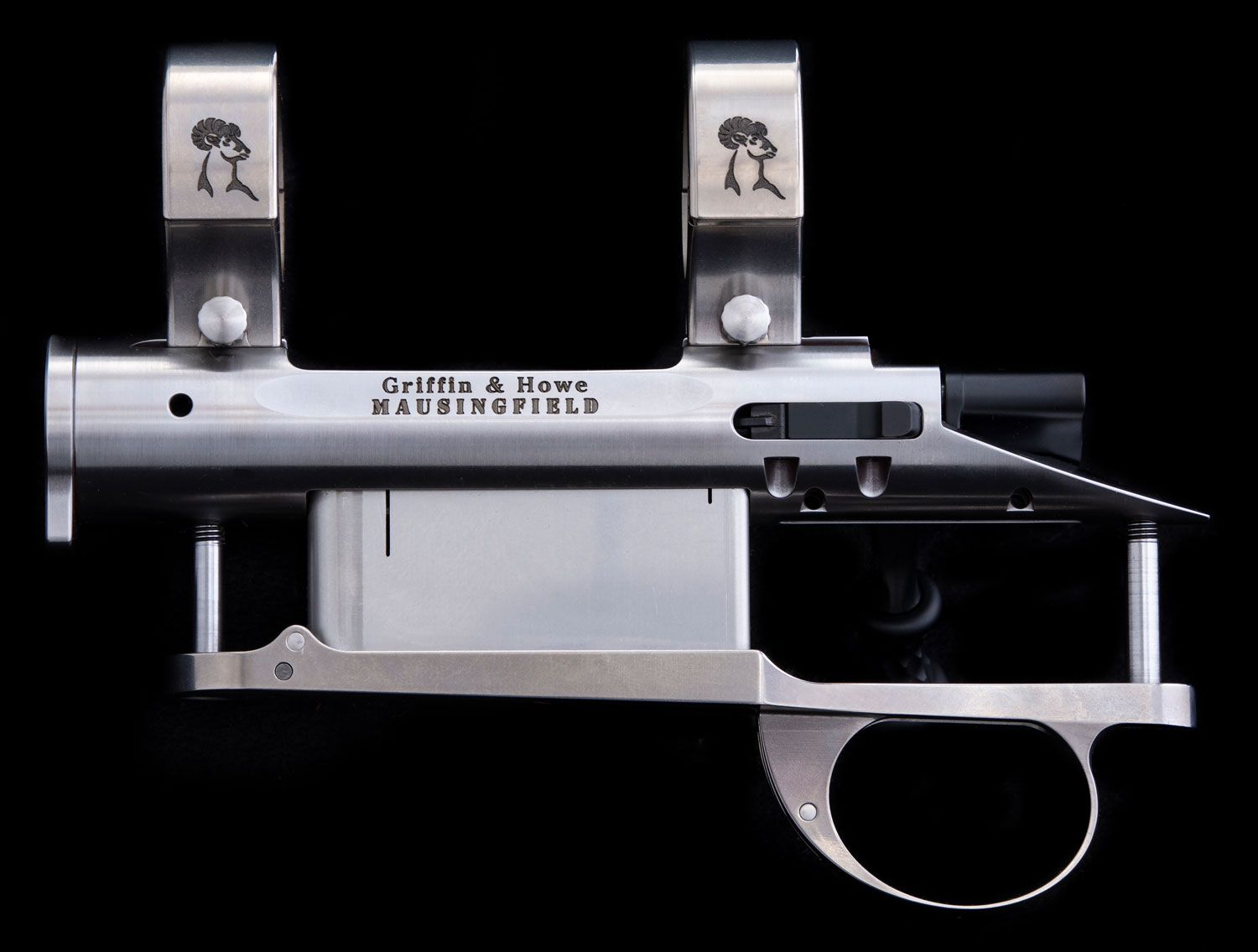
It’s been often said that a trigger is a component that does not add to a rifle’s inherent accuracy. An exceptional trigger certainly can, however, make a big difference in how well a shooter can accurately make his or her shot. To that end, All American rifles are fitted with a Huber two-stage trigger—in essence a match-grade trigger with the ruggedness and durability necessary in a big game rifle. Huber triggers use anti-friction ball bearings that provide a smoother and faster lock time.
Certainly, the most visually striking aspect of the All American rifle is its Proof Research Sendero Light carbon fiber wrapped stainless steel barrel. This high-tech tube, free-floated in G&H’s classic walnut stock, exemplifies the modern versus traditional components on this rifle. “Essentially,” Cote makes the point, “it is a heavy contour barrel with a significant amount of the steel removed and replaced with a carbon fiber wrapping. So, now you are getting strength, rigidity and better heat dissipation without the weight.”
I’ll admit that the “wow” factor of this rifle is off the charts. Made to measure and strictly hand-built, the All American rifle combines state-of-the-art components with a drop-dead gorgeous piece of wood. At the same time, it is a totally practical hunting rifle with the correct weight—on average seven pounds without optics—balance and “trimness” to make it an ideal big game rifle intended for all-day carry in the field.
The cherry on this sundae, though, is the rifle’s outstanding accuracy. In any of the calibers offered (22-250 Rem., 243 Win., 6.5 Creedmoor, 270 Win., 7mm Rem. Mag., 308 Win., 300 PRC or 300 Win. Mag.) the All American comes with a 1/2 MOA guarantee with Hornady ELD-X ammunition. While it certainly doesn’t have the look of today’s “chassis” rifles, the All American can hold its own “way out there,” well beyond the distance at which even experienced and well-practiced hunters will take a shot at a big game animal.
I had the opportunity to shoot an All American rifle that had been built for G&H’s CEO Steve Polanish at G&H’s signature 1,000 yard range. The rifle had been dialed in by G&H head rifle instructor Mike Murphy and, serving as the “trigger monkey,” I hit steel plates on the first shot at 600, 700 and 800 yards out.
One of the key advantages with the G&H operation is that all its facilities are on one campus. From the gunsmithing and gunmaking workshop, it’s just a short Polaris Ranger ride to the rifle range where Mike Murphy works with you to make sure your new All American is properly set up and sighted-in. Mike’s marksmanship coaching is excellent and, unless you’re fresh out of sniper school, you’ll clearly benefit from a few hours on the range with him.
G&H has taken marksmanship development a step further with the introduction of its Rifle Expedition (Excursion) program, a series of three excursion ranges – North American, Western and Rockies – where life-size game silhouettes are set out in natural terrain at a variety of distances at which various big game species might typically be encountered in the field.
With an available 4,000 acres of rolling terrain, both open and wooded, each excursion course is a realistic training ground for hunting different big game animals. Participants are encouraged to bring their hunting pack and tripod and practice shots from various shooting positions and at different distances. Using the expertise and full range of resources at G&H, the goal is to create a shooting “system,” one that combines the capabilities of the All American rifle with the skills of the man, or woman, behind the stock.
Almost 100 years ago, Seymour Griffin took a bold step forward and helped to create an important piece in the mosaic that would define the American sporting experience. Today, a band of highly talented employees at Griffin & Howe are building on that legacy. From everything I’ve seen, they certainly have earned a trip around the bases.
This article originally appeared in the 2020 Guns and Hunting issue of Sporting Classics magazine.

